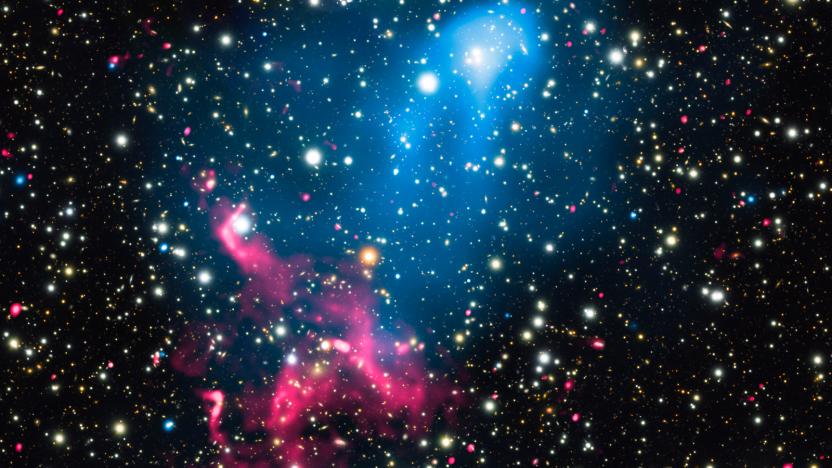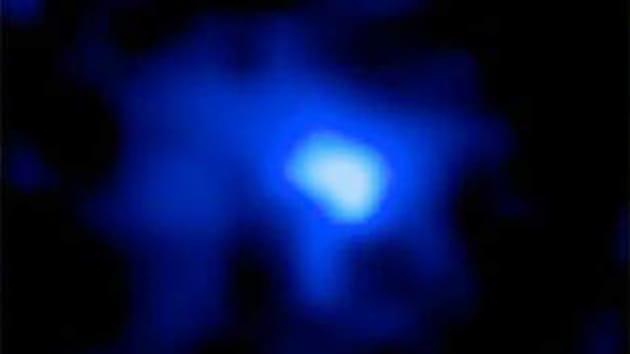KeckTelescope
Latest

NASA: We found 7 Earth-sized planets just 40 light years away
During a news conference in Washington DC Wednesday, NASA revealed that, using the Spitzer Space Telescope, they've found seven new Earth-sized planets orbiting a star just 40 light years away from us. What's more, three of those exist within the "Goldilocks zone" which could be habitable for life.

Scientists discover a cosmic-scale particle accelerator
Suddenly, even the Large Hadron Collider seems downright quaint. Researchers have found a combination of cosmic phenomena that's creating the universe's largest known particle accelerator. At least one supermassive black hole in a galaxy cluster has created a electromagnetic tunnel that's accelerating gas to high speeds, only for the gas to travel even faster as it interacts with shock waves from another cluster colliding with the first. The result is particles traveling at a significant portion of the speed of light -- no mean feat for anything that isn't, well, light.

Strange galaxy is made almost entirely of dark matter
A galaxy isn't big just because it has many stars in it. A worldwide research group has discovered that a galaxy in the Coma cluster, Dragonfly 44, consists of 99.99 percent dark matter. It has about as much mass as our own Milky Way galaxy, but far fewer stars. The team determined the presence of the invisible, mysterious substance based on the motions of the stars themselves -- there were too few of them to be moving so quickly. If there weren't a gravitational force like dark matter to hold them together, those stars would simply fly away.

Researchers find new 'most distant' galaxy in the universe
Peering through the voids of space is a lot like time travelling: the deeper we gaze into a seemingly endless Universe, the further back in time we can see. Now, a team of researchers led by astronomers from Yale University and UC Santa Cruz have announced that they've discovered the most distant galaxy to date. In fact, the galaxy, known a EGS-zs8-1, is so ludicrously far from Earth that light just now reaching us from it is about 13 billion years old. To put that in perspective, the Universe itself is 13.8 billion years. That means this galaxy began forming stars when the Universe was only 5 percent of its current age -- barely 670 million years after big banging into existence.

The Big Picture: measuring the 'Eye of Sauron' galaxy
The galaxy you see here (NGC 4151) may be best-known for looking a bit like the Eye of Sauron in the Lord of the Rings movies, but it's now much more important than that -- it may be the key to mapping the universe. Researchers at the Univerity of Southampton have developed a measurement technique that helped them gauge the distance of NGC 4151 (and possibly other galaxies) with greater precision than any previous method would allow. Instead of using the light from other galaxies as a rough yardstick, the team compared the physical size of the dust ring around NGC 4151's black hole against the apparent size taken from infrared readings. These relatively concrete pieces of information helped them narrow down the distance of the galaxy from a very broad range of 4 to 29 megaparsecs to 19, or about 62 million light years; even with 10 percent uncertainty, that's a vast improvement.

Scientists capture birth of new planet on camera, mother and child doing just fine
After all the pushing, squeezing and screaming, the universe has finally given birth to a new planet, in an eruption that two scientists managed to capture on film. The newborn pile of planetary pudge, named LkCa 15 b, was discovered by Drs. Michael Ireland and Adam Kraus, who, over the course of 12 months, successfully documented the event using Keck telescopes and a technique called aperture mask interferometry. Their findings, published in Astrophysical Journal describe a Jupiter-like gaseous planet that likely began forming some 50,000 to 100,000 years ago. Located about 450 light years from Earth, it's also the youngest planet ever observed, having dethroned the previous record-holder, which was about five times older. According to Ireland and Kraus, the LkCa 15 b is still being formed out of a circle of dust and gas (pictured above) surrounding a 2-million-year-old star. By observing a "young gas giant in the process of formation," the researchers hope to find answers to fundamental questions that have long eluded them. "These very basic questions of when and where are best answered when you can actually see the planet forming, as the process is happening right now," Kraus explained to the AP. Head past the break to see an artist's rendering of the newborn, and if you get the chance, be sure to send flowers.


